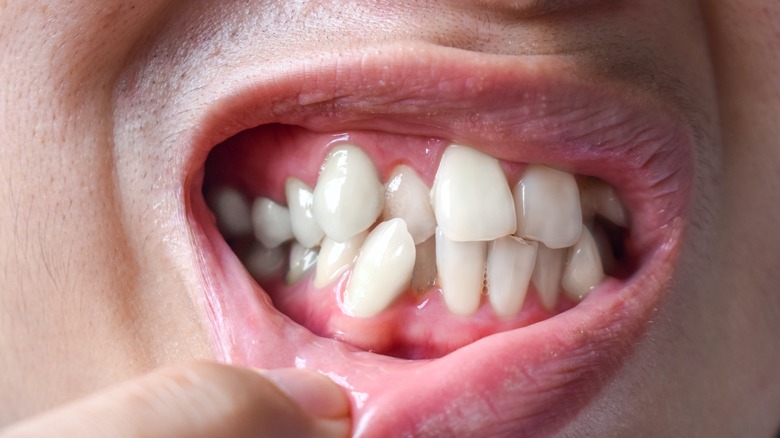The Shape Of Your Mouth Has An Unexpected Effect On Your Health
The roof of your mouth isn't an area of your body that gets much thought until you burn it on your morning caramel macchiato. Then, you might baby the area while you wait for the burn to heal. However, the shape of the roof of your mouth plays an essential role in the overall health of your body. A narrow palate can lead to several issues, like sleep apnea, crowding teeth, and speech issues.
Before breaking down how this condition can affect you, it's good to know your way around your palate. According to StatPearls (via the National Library of Medicine), the palate forms the roof of your mouth and separates it from your nasal cavity. It comprises a hard area (roof of your mouth) and a soft area (muscle fibers and tissue in the back of your throat). A narrow palate means the palate is more narrow and higher than average, according to the National Library of Medicine. The formation of the palate starts in the womb, but several factors can affect the shape, like pacifier usage and thumb sucking. It has also been found that a tongue tie could play a role in developing a narrow palate (per Revista Paulista de Pediatria).
We'll take you through the different health conditions related to a narrow palate and discuss different treatment options to help correct palate-related issues.
Obstructive sleep apnea related to narrow palate
Obstructive sleep apnea (OSA) is typically diagnosed in adults; however, it can be found in children. According to the Mayo Clinic, OSA happens when a person repeatedly starts and stops breathing while sleeping. Specific symptoms include sleepiness in the daytime, loud snoring, waking up choking or gasping, trouble focusing, mood changes, and high blood pressure.
The reason those with narrow palates experience sleep apnea is due to the increased nasal resistance and displacement of the tongue, according to Rachel Barnhart, D.D.S. When your tongue is relaxed, it has a specific resting position. Dentist Dr. Ron Baise told Healthline, "Your tongue should be touching the roof of your mouth when resting. It should not be touching the bottom of your mouth. The front tip of your tongue should be about half an inch higher than your front teeth." However, a narrower-than-average palate disrupts this tongue placement and makes it harder for air to find its way in.
Treatment for this specific type of OSA requires using an expander to correct the palate, known as distraction osteogenesis maxillary expansion (DOME) (per Otolaryngology–Head and Neck Surgery). Patients are fitted with an expander that works to open up their palate and make breathing easier. If the palate isn't fixed, a CPAP machine can help keep air flowing as the person is sleeping.
Teeth crowding and misplacement from narrow palate
Your palate also plays a significant role in the spacing and alignment of your teeth. When your palate is too narrow, the adult teeth don't have enough room to grow and spread out. This affects more than just your smile. According to Smilelogic Orthodontics, crowded teeth can cause a problem with impacted teeth. Because there is a lack of space, adult teeth can get stuck, leading to pain and risk to the teeth. They also note crowding leads to the teeth wearing unevenly, leading to jagged teeth. It's also hard to clean them properly, which can lead to periodontal disease down the road.
Treatment for teeth crowding depends on the person's age. Northwest Orthodontics notes rapid palate expanders can be used in children whose bones aren't yet fused to help widen out the palate and realign the teeth. Adults with narrow palate and teeth crowding have a few options available as well. Expanders might be used that work to stretch out the fused bones slowly. Those with extreme cases might have to get a surgical expander. Beyond expanders, braces, invisible aligners, and teeth extractions might be used to help to realign the teeth.
Speech issues caused by narrow palate
Learning how to talk is more than just learning to move your lips and tongue; it involves your palate as well. As your speech develops, you need to use the tongue and roof of your mouth in unison to create specific sounds. Additionally, the palate works in unison with the tongue to close off when speaking occurs, according to NHS Cambridge University Hospitals. When the palate is too narrow, it changes how the tongue touches it during speaking, making some sounds harder to create.
According to ENT Clinic, two different therapies may help to correct speech disorders due to a narrow palate. Articulation therapy targets speech errors that regularly occur due to the difficulty producing specific sounds like "s." Phonology therapy helps detect and correct sound errors. For example, if a child or adult has difficulty making the sounds at the ends of words. Each of these different therapies takes an individualized approach to help to correct speech errors.
Those with severe difficulties due to their narrow palate might need medical interventions to correct the palate so the sounds can be made. For example, those with a narrow palate and tongue-tie may have a frenotomy to snip the frenulum, per Healthline. Palate expanders and jaw surgery can also be used. This is especially true for those with severe disorders due to a narrow palate, per Amy Skinder-Meredith, Ph.D., CCC-SLP (via Speechpathology.com).




